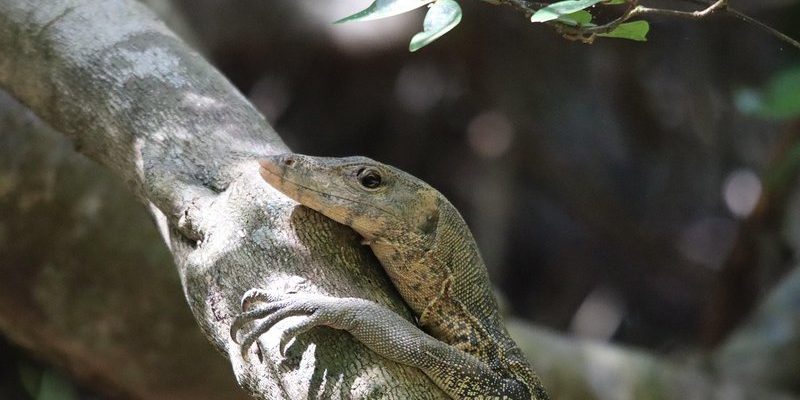
Let’s dive deeper into what makes monitor lizards so special. These remarkable reptiles are found in a variety of environments, from tropical forests to savannas. Each species has its own unique set of behaviors and interactions with other species. Simply put, they’re integral to their worlds, acting as both predators and prey. So, what exactly is their role in the ecosystem? Let’s explore.
What Are Monitor Lizards?
Monitor lizards belong to the Varanidae family, which includes around 80 different species. From the small and agile Bengal monitor to the massive Komodo dragon, these reptiles vary significantly in size and habitat. They can grow anywhere from a few feet to over ten feet long!
These lizards are highly adaptable, found across Africa, Asia, and Australia. They thrive in diverse habitats, including rainforests, deserts, and even urban areas. This flexibility is key to their survival, as it allows them to occupy various ecological niches.
Monitor lizards exhibit a range of fascinating behaviors. They’re known for their strong sense of smell, which they use to hunt for food and avoid threats. With their sharp claws and powerful jaws, they’re well-equipped to catch prey, which includes insects, small mammals, birds, and even other reptiles.
The Predator-Prey Dynamic
One of the main roles monitor lizards play in their ecosystems is that of a predator. They sit comfortably at the top of the food chain in many of their habitats. By hunting small animals, they help control their populations, preventing any one species from overpopulating.
You might be wondering how this works in real life. Imagine a thick forest where small mammals are free to multiply unchecked. Without predators like monitor lizards, these mammals could quickly consume available resources, leading to habitat destruction. Monitor lizards step in and keep these populations in check, maintaining balance in the ecosystem.
Additionally, as monitor lizards consume their prey, they become part of the food web themselves. Larger predators, like crocodiles and big birds of prey, often target these lizards. This means monitor lizards also serve as an essential food source for other animals, reinforcing their importance in the ecosystem.
Scavengers of the Ecosystem
In addition to being fierce predators, many monitor lizard species are also scavengers. They don’t just wait for live prey; they actively seek out carrion, which is dead animals. By consuming decaying organisms, monitor lizards help clean up their environment.
Think about it this way: scavengers are nature’s cleanup crew. They play a crucial role in recycling nutrients back into the soil. By eating dead animals that might otherwise rot and attract pests, monitor lizards contribute to a healthier environment.
This scavenging behavior can also impact the populations of bacteria and insects that thrive on carcasses. Fewer dead animals mean fewer pests, which is great for the overall health of the ecosystem.
Monitor Lizards: Seed Dispersers
Believe it or not, monitor lizards also contribute to plant health and growth. As they eat fruits and vegetables, they often consume seeds along with the flesh. These seeds can pass through their digestive systems undamaged. When monitor lizards defecate, they deposit seeds in new locations, aiding in plant dispersal.
This process is crucial for the survival of many plant species, especially in ecosystems where certain plants rely on animals for propagation. Without these seed dispersers, some plants might struggle to grow or spread.
This relationship highlights the interconnectedness of all species within an ecosystem. Monitor lizards are not just hunters; they’re also caretakers of plant life.
The Impact of Habitat Destruction
Unfortunately, the role of monitor lizards in their ecosystems is at risk due to habitat destruction. Urban expansion, agriculture, and deforestation are rapidly diminishing their natural habitats. Without a place to live and hunt, monitor lizard populations are declining.
The loss of monitor lizards can lead to imbalances in their ecosystems. With fewer predators, prey populations may explode, leading to overgrazing and depleted resources. This chain reaction can adversely affect plant life and other animal species.
Moreover, as scavengers, the decline of monitor lizards means that dead organisms may linger in the environments longer than they should, which can lead to unsightly and unhealthy conditions.
Conservation Efforts and Importance
To ensure that monitor lizards continue to fulfill their essential roles in ecosystems, conservation efforts are crucial. Protecting their habitats through the establishment of wildlife reserves and promoting sustainable land use are vital measures.
Education plays a significant role, too. Raising awareness about the importance of monitor lizards can help the public appreciate their contributions. This could lead to increased support for conservation initiatives and laws protecting their habitats.
By prioritizing conservation, we not only help monitor lizards but also protect the intricate web of life that depends on them. After all, every creature, no matter how big or small, has its role to play in maintaining a healthy ecosystem.
In summary, monitor lizards are much more than just fascinating reptiles to observe. They are key players in their ecosystems, acting as both predators and scavengers whilst supporting plant life through seed dispersal. Unfortunately, habitat destruction poses a significant threat to their survival, which can lead to severe consequences for the ecosystems they inhabit.
If we all take steps toward conservation, we can ensure that monitor lizards continue to thrive and fulfill their roles for generations to come. Understanding and appreciating the importance of these lizards can help us make better choices for our planet and its precious biodiversity. So next time you see a monitor lizard, think about the big impact it has on its world!

